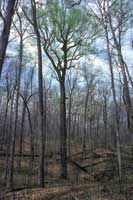Of Indiana's original 20 million acres of forest, fewer than 2,000 acres of old-growth forests remain intact. Most of the sites that remain are now protected as nature preserves, and many have been selected as National Natural Landmarks.

Donaldson's Woods
The first thing you notice when you enter an old-growth woods is the sheer size of the trees. Giant hardwoods 3 and 4 feet across at the base soar more than 100 feet to the canopy above. The oldest trees are more than 250 years in age; many of Indiana's old growth oaks were producing acorns long before the American Revolution.
Layers
Beneath the canopy, multiple layers of vegetation mark the descent to the forest floor. At 50 feet, younger trees wait in the shade of their parents for the openings that will allow them to attain canopy stature. Understory species such as dogwood, redbud and ironwood form a third layer of green at 20 to 30 feet. Lower still are the shrubs and herbs which occupy the forest floor.
Habitat Provided
Hollow trunks and tree holes in these woods provide habitat for squirrels, raccoons, bats, wood ducks, woodpeckers and a myriad of other birds and mammals. Dead trees and snags remain standing until a windstorm or other disturbance sends them crashing to the ground.
Far from being a waste of wood, however, these fallen trunks now enter a new stage of the natural cycle. Each log becomes its own mini-ecosystem, complete with a teeming array of termites, ants, beetles, centipedes, millipedes and other invertebrates.
These in turn become food for salamanders, shrews, mice and other denizen of the forest floor. The rotting wood is further broken down by fungi and bacteria. The wood is gradually converted to humus, replenishing the soil and completing the natural nutrient cycle.
Visit our List of Nature Preserves page to discover Indiana's dedicated Nature Preserves protecting old growth forest communities. A sample of these include:
- Bendix Woods Nature Preserve - St. Joseph County
- Donaldson's Woods Nature Preserve - Lawrence County
- McClue (Charles) Nature Preserve - Steuben County
- Pine Hills Nature Preserve - Montgomery County
- Rocky Hollow-Falls Canyon Nature Preserve - Parke County
- Shrader-Weaver Nature Preserve - Fayette County
- Wesselman Woods Nature Preserve - Vanderburgh County
A generation ago ecologists J.E. Potzger and Ray Friesner of Butler University described Indiana's old-growth forests as "...monuments representative of the once massive eastern deciduous forest, to which generations of today and tomorrow might make their pilgrimage, to see in impressive miniature what pioneers of four score years tell us about the forest primeval which towered over the cabins of their boyhood days." These old-growth forests are precious in ways that cannot be measured.
